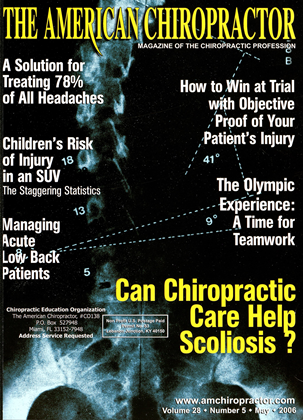Protocols. W ITH THE GROWING interest from the public for chiropractic care in pregnancy, it is important that we clarify our parameters as Doctors of Chiropractic when providing care for this population. It is also significant for us to recognize that there are specific techniques and protocols particular to pregnancy. The Webster Technique is a popular sacral analysis and adjustment that establishes balance in the female pelvis, and the attached uterine ligaments. Developed by Dr. Larry Webster, for women whose babies were presenting breech, it was initially called the "the Webster Breech Turning Technique" and interpreted to be used only as such. At the time of his passing, in 1997, limited attention into the biomechanics of this technique had been given, and its 85-95% recorded success rate encouraged chiropractors to use this technique only late in pregnancy, when mothers started care with a breech presentation. This title and interpretation has since been revised by the International Chiropractic Pediatric Association. In 2000, the ICPA initiated the Proficiency Certification for the Webster Technique. In the development of this Proficiency Class, I reviewed female pelvic biomechanics and determined a relationship between the Webster analysis and the causes of dystocia as outlined by Williams Obstetrics. Based on these findings, it became clear that the Webster technique was far more significant (and chiropractically relevant) than a "breech turning technique." These findings established the technique as a significant means of decreasing the potential for dystocia in labor. With this theory, the technique was renamed as simply "The Webster Technique," and the protocol was changed to utilize this sacral analysis, adjustment and soft tissue contact throughout pregnancy to facilitate pelvic alignment for a better birth. The Webster Technique, therefore, is defined as specific chiropractic analysis and adjustment to be used throughout pregnancy that reduces nerve system stress, balances pelvic muscles and ligaments which, in turn, reduces the potential for intrauterine constraint and, therefore, allows for a safer, easier delivery for both the mother and baby. The ICPA lias sent out numerous notifications defining its current position and protocols about The Webster Technique and has been in touch with all pediatric groups in chiropractic requesting they stop using the term "breech turning" when referring to this protocol. The term and former protocol are misleading and inaccurate for both the practitioner and the patient and should not be used. Practitioners who learned the technique as a "breech turning" technique owe it to themselves and their patients to update their knowledge and skills. The ICPA hold numerous Webster Certification classes internationally. As more mothers seek chiropractic care in pregnancy, it is the hope of the ICPA that doctors of chiropractic will recognize the importance of advancing their skills to effectively care for this population. Pregnancy is the beginning of the family chiropractic wcllncss lifestyle and our care needs to include services that will enhance safer and easier births for both the mother and baby. For specifics about the technique, visit the ICPA website: www.icpa4kids.com. Dr. Jeanne Ohm instructs internationally on the topic "Chiropractic Care for Pregnant Women and Children. " She is executive coordinator of the International Chiropractic Pediatric Association and can be reached via their website at innr. icpa4kids.com. rntTW
 View Full Issue
View Full Issue
